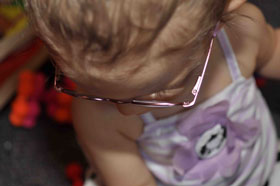Have the child put on their new glasses and wear them for a short period of time. Go for a full ten minutes if you can. Have them play; go for a walk. We have an iPad in our office and use it often for the little kiddos. You'd be surprised how comfortable they are with an iPad. There are many free apps that you can download for the kids to play.
There is a point where everything looks good to our eye. The glasses are straight, the pressure is perfect on the sides of the head, and the temples are fit properly behind the ears. Don't be fooled by looks, though. It's not how they look; it's how they wear. That's why this type of fitting is so important. When we allow them to wear their glasses for a while, we can identify pressure points that will not be seen initially. Because children's bridges often develop asymmetrically and their skin is soft and tender, any unequal or unbalanced weight on will cause discomfort. This discomfort WILL cause the child to take their glasses off and become non-compliant.
It is important to observe them while they are playing or reading. Your patient may be non-verbal but they certainly do communicate. Nothing like ripping off their glasses to let you know that something is wrong! Sometimes they will squish their nose up, poke at their ears, look over the glasses, and rub their eyes, a whole host of behaviors. Then, the real question is, why are they doing this?

I've had a little one move their glasses by contorting their faces into all sorts of shapes until the nose pads hit a comfortable spot. When they do this, I just go with it. "So this is where you like the nose pads touching, huh?" No problem. If it's sitting lower on the nose, pull the pad arms down on the frame so the pads sit in the acceptable spot but the frame still sits up higher. A verbal patient would just say, "These nose pads are uncomfortable here," but the non-verbal patient will simply do what they need to be comfortable, even if that means pushing the glasses down their nose, or setting them on the floor.
If they start picking at their ear, take a look...does it pull tight or touch a spot on one side and not the other, which causes it to feel funny to them? If so, make the necessary adjustments. If they keep trying to rub their eyes or pull the glasses away from their face and then put them back, chances are good that their eyelashes are touching the back of the lenses. Adjust accordingly, with nose pads, pull the arms away from the frame front giving more space for the eyelashes.
Once they seem to be leaving the frames alone, wait about ten minutes and then remove the glasses. This is where balance comes into play. There are six points of touch on any pair of glasses. Each side of the nose if they have pad arms (or the entire bridge itself if it is a saddle bridge), the tops of each ear and finally the backs of each ear.
Once the glasses have been worn for about ten minutes, you can take them off and you will likely see some sort of impressions left behind. These impressions are indicators of how the glasses will "wear" over a longer period of time. If a child is given glasses that are even a little uncomfortable, they will learn to associate their glasses with discomfort. They will push them away and cry at the very sight, choosing to see poorly over being uncomfortable.
I can't possibly go over the exact adjustments for every mark, but I can help you identify the marks that cause problems. It's worth noting that some little ones have sensitive skin and mark quickly. Ask the parents, they will know. Take this into account when observing. Sensitive skin will mark quickly and look more pink or red than average, but the marks will still fade quickly if the glasses are adjusted properly.

Danielle Crull, ABOM, owns A Child's Eyes, an independent optical store specializing in pediatrics in south central Pennsylvania. She became a Master Certified Optician in 1997, and her thesis topic concerned the differences between dispensing to children and adults. She lives in Dillsburg, Pa., with her husband and three children, all of whom work in her business.












